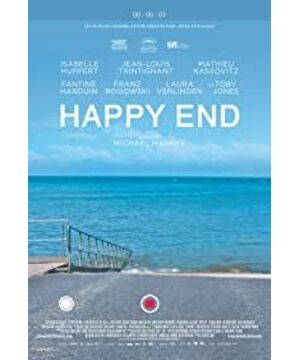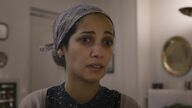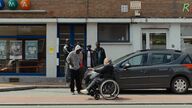The culmination of "Happy Ending" is that it is not only constructed by the body and shadow of Haneke's past series of works, but also intervenes in the film's image carrier through new media such as mobile phone live broadcast and social network, becoming a new tool for film information transmission. It reflects the undercurrent and inner fragmentation of a European middle-class family in the fragmented and seemingly disorganized narrative structure, and it secretly points to the hidden crisis of current European social contradictions.
Everyone in this middle-class family has contact with immigrants, and the nightmare they encountered is like "Hidden Camera". The ethnic identity of the immigrant housekeeper can be related to "Paris Ukiyo-e", and the old man George can be said to be the prototype in "Love" , The mental illness and cruel behavior of the little granddaughter are like the little boy obsessed with violence in "Benny's Video", Paul indulging in perverted sexual behavior, and like Huppert in "Piano Teacher"... Except for the characters In addition to echoing the theme of expression, "Happy Ending" also has the typical style labels of Haneke's films: fixed long shots, the use of door frames and mirror frames to form a cramped and fragmented composition, the third-person monitor perspective, and the space outside the painting. Participation of voice...
"Happy Ending" is like Haneke's summary statement of his own sequence works at this stage, but this is by no means standing still, because in this state of assembly, the film not only goes back to the past, but also It is generally criticized that the narrative is loose, the transitions are disconnected, the characters are superficial, etc. I hold the opposite opinion and tend to do it intentionally, because in my opinion, "Happy Ending" "The author is not just Haneke, but more of the audience in front of the screen.
In the official plot introduction of "Happy Ending", it is written that this is a "Snapshot" about a middle-class family. This word is crucial to our understanding of Haneke's creative intention. "Snapshot" is both a snapshot / The dual meaning of capture and brief introduction, therefore, even if "Happy Ending" has the same fragmented narrative structure as "71 Fragments of the Chronicle of Chance" and "Paris Ukiyo-e", in the switching and connection of scenes, the reason why there is no such The smoothness, closeness, and fit of the two films (for example, Ukiyo-e in Paris presents three narrative lines smoothly in a scrambled scene) can be attributed, on the one hand, to this focused group portrait, the large number of families, On the other hand, it is the inevitable result of the shooting concept of snapshot, which may also be the effect Haneke expected. In this complex relationship chain intertwined by the inside and outside of the family, it travels the direction of the story and the orientation of the characters in a quick transition and concise way. The audience was at a loss.
However, Haneke is doing this as a new attempt to narrate the film. When many creators still firmly hold the causal relationship of the story, or occupy the right to interpret the film, he in "Happy Ending", more Acting as a leader who provides a glimpse into the life of this family character and observation material, the audience must quickly and completely capture important information from this snapshot-style scene shot, and at the same time understand Haneke as a writer-director from this information. The clear attitude and position of the film, and then integrating the information, self-interpreting, and finally constructing the final appearance of the film, this is obviously not a simple and audience-friendly approach. The audience is often a lazy receiver, not a maker. But what Haneke hopes in "Happy Ending" is to make every audience a second author of the film.
In all of Haneke's past works, the story events either coexist with a clear cause and a blank result, or the abrupt ending can't find a trigger that can be directly explained. For example, the humiliation of illegal immigrants in the first scene of "Paris Ukiyo-e" affects the living conditions of the participants in subsequent events, and ends with the unknownness of life, or, as in "The Seventh Continent", the last family of three passes the test. At home, mass suicide, the film does not provide directly accessible reasons for suicide. "Happy Ending" is a narrative method that combines these two story events. On the one hand, the old man George finally rode a wheelchair to the sea in order to die. This behavior was clearly explained in his dialogue with the barber and granddaughter. On the other hand, why the granddaughter poisoned his mother, and why Annie's cowardly son ended up inviting black immigrants to disrupt his mother and fiancé's engagement dinner, the movie doesn't directly provide reasons.
Haneke once said, "I like to use detective novels to hold the audience tightly in their seats." This is exactly the case in "Happy Ending". Every well-designed scene is woven and hidden a lot of information points to be decoded. , and these are the keys to unraveling the above confusion, and it is the audience themselves who unravel the unknown password. For example, at George's birthday party, Annie's son asked everyone to applaud the immigrant butler's wife who was cooking and called her a "slave". No one in the room responded. What flashes is Annie's son's stance on immigration, and perhaps implicitly one of the reasons why he later disrupted his mother's banquet; when George was on the road seeking help from black immigrants, a white man appeared, seemingly to deport them, Hane. K's way of handling this scene is to overshadow their conversations with the sound of cars, allowing the audience to understand themselves from their physical interactions. This snapshot-like life event seems to be the manifestation of the conflict between European immigrants and white people throughout the film. Condensed to the point; Annie's son danced insanely while singing Sia's "Chandelier", and if the audience watched the MV for this song, it might be another channel to understand and unravel his crazy behavior.
"Happy Ending" is another progression and improvement of the fragmented narrative concept, suspense and conflict creation methods by Haneke from "71 Fragments of the Chronicle of Chance" to "Paris Ukiyo-e". The fragmentary scenes seem to be loosely connected, but they can infinitely extend the breadth of this middle-class family life and the depth of character relationships. And quite surprisingly, we can also see Haneke breaking through the dark humorous irony that his previous works did not have in this film.
"Happy Ending" seems to be an incomplete work specially created by Haneke. The creator of the secondary integration of this text and image is the audience. It is a pity that some people give up halfway, and some people fall asleep, so they can accept this narrative and expression technique It seems that only fans who really like Haneke are left.
5.23 Written in Cannes
, originally published by Phoenix Entertainment: http://ent.ifeng.com/a/20170524/42937121_0.shtml
View more about Happy End reviews











